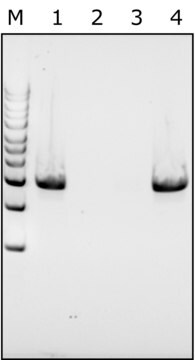L4402
Lysostaphine from Staphylococcus staphylolyticus
BioUltra, ≥97% (SDS-PAGE), Protein 40-60 % by biuret, ≥2,000 units/mg protein
Synonyme(s) :
Glycyl-glycine endopeptidase
About This Item
Produits recommandés
Source biologique
bacterial (Staphylococcus sp.)
Niveau de qualité
Gamme de produits
BioUltra
Pureté
≥97% (SDS-PAGE)
Forme
lyophilized powder
Activité spécifique
≥2,000 units/mg protein
Poids mol.
25 kDa
Composition
Protein, 40-60% biuret
Concentration
40—60% protein
Technique(s)
cell based assay: suitable
Adéquation
suitable for cell lysis
Spectre d'activité de l'antibiotique
Gram-positive bacteria
Application(s)
diagnostic assay manufacturing
Mode d’action
cell wall synthesis | interferes
Température de stockage
−20°C
Vous recherchez des produits similaires ? Visite Guide de comparaison des produits
Catégories apparentées
Description générale
Actions biochimiques/physiologiques
pH optimal en termes d'activité : ~7,5
Définition de l'unité
Forme physique
Notes préparatoires
Mention d'avertissement
Danger
Mentions de danger
Conseils de prudence
Classification des risques
Resp. Sens. 1
Code de la classe de stockage
11 - Combustible Solids
Classe de danger pour l'eau (WGK)
WGK 3
Point d'éclair (°F)
Not applicable
Point d'éclair (°C)
Not applicable
Équipement de protection individuelle
Eyeshields, Gloves, type N95 (US)
Certificats d'analyse (COA)
Recherchez un Certificats d'analyse (COA) en saisissant le numéro de lot du produit. Les numéros de lot figurent sur l'étiquette du produit après les mots "Lot" ou "Batch".
Déjà en possession de ce produit ?
Retrouvez la documentation relative aux produits que vous avez récemment achetés dans la Bibliothèque de documents.
Les clients ont également consulté
Notre équipe de scientifiques dispose d'une expérience dans tous les secteurs de la recherche, notamment en sciences de la vie, science des matériaux, synthèse chimique, chromatographie, analyse et dans de nombreux autres domaines..
Contacter notre Service technique











